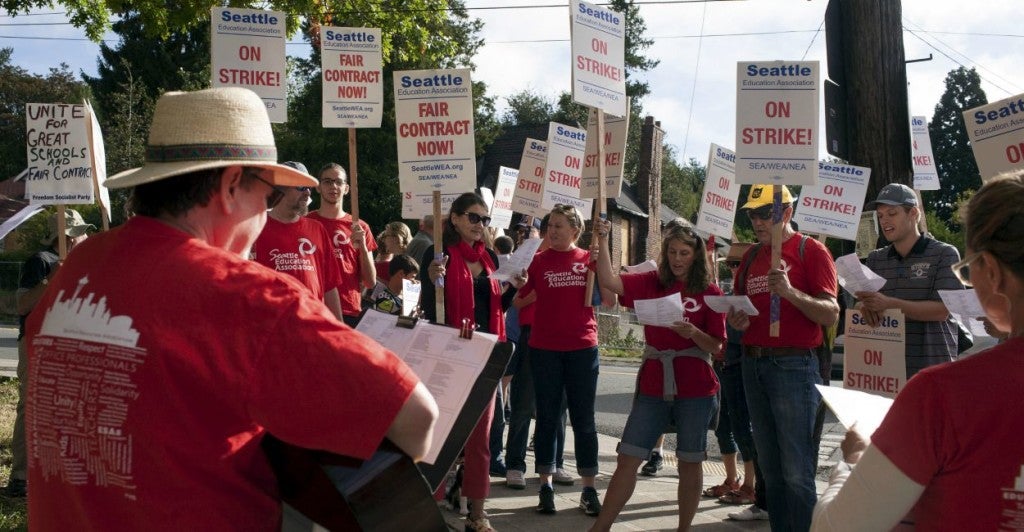It’s back to school time again, but before you start helping your kids out with their math homework, let’s look at some numbers that may be easier to digest—but difficult to believe:
53,000: Number of students in Seattle who did not go back to school on Wednesday as public school teachers voted to strike. This comes after failed negotiations between the Seattle Educators Association and the Seattle School Board.
Teachers have a variety of demands, including, among other things, “professional” pay and “educator work relief.”
Seattle teachers’ median pay is $60,400, not including benefits, exceeding Seattle’s median income of $43,200.
The union wants a nearly 17-percent pay increase for teachers, to compensate for the district’s proposal to add 30 minutes to the school day. And although teachers in Seattle’s charter schools—just this week deemed unconstitutional by the state supreme court—are uncertain of their own futures, they are still showing up to work.
54 Percent: The percent of public school parents who oppose teachers using Common Core State Standards in their children’s classrooms.
A 2015 PDK/ Gallup Poll Report titled “Common Core out of Favor” found that parental support for Common Core continues to drop among public school parents. Education Next found that support for Common Core nationally has dropped from 65 percent in 2013 to 53 percent in 2014 and is down to just 49 percent in 2015.
90 Percent: The percent of college freshman who do not pay full price for tuition.
According to a new study by the National Association of College and University Business Officers, tuition discounting (“a measure of how much financial aid is needed to enroll the millions of students who are headed to college this year”) is at an all-time high.
Which raises the question: if students aren’t paying for tuition, who is?
The Obama administration’s continual efforts to make student loan forgiveness more generous leaves taxpayers on the hook for a significant slice of outstanding student loan debt—estimated at around $1.12 trillion.
The massive amount of student loan subsidies in today’s economy has undoubtedly distorted the market, and high debt levels have kept many of today’s young people from achieving the American dream.
Former Indiana governor and current president of Purdue University Mitch Daniels has connected high student loan debt to the rapid decline in small business ownership since 2010.
Student loan debt also encourages graduates to put off other economic and social activities such as homeownership, car ownership, marriage, and childbearing.
$445 million: Price tag for New York’s subsidized “free” preschool. Mayor Bill de Blasio calls the new vast expansion of fully funded preschool a “model” to be followed all over the country.
In addition to subsidizing middle- and upper-income New Yorkers, who are already paying for preschool on their own, private preschools are in danger of being crowded out by a large “free” government program.
Evidence from other large-scale preschool programs, such as the federal Head Start program, has shown no impact on children’s cognitive abilities, their social-emotional well-being, or parents’ parenting practices, according to the Department of Health and Human Services.
1490: Average SAT score out of 2400 for 2015 test takers. This marks a 7-point drop from 2014, with math scores at their lowest since 1999.
While SAT scores in recent years have either been improving or constant, the 2015 results are 7 points lower than the previous year.
Rick Hess of the American Enterprise Institute warns that this may indicate that any progress our schools have made at the elementary and middle school levels may have diminished by the time students reach high school, arguing further that “NCLB’s command-and-control effort to improve schooling has been producing results that have given a false sense of progress.”
But the one positive number:
257,282: The increase in the number of students benefiting from private school choice options since 2004. More and more parents are now able to choose options that best fit their children’s unique learning needs.
Thanks to the growth in school choice options, children can access an education that works for them, not remain consigned to the closest government-run school.
From 4-year-olds to college freshmen, improving education should focus on infusing choice at every level through student-centered policies such as charter schools, Education Savings Account options, and locally established performance standards and assessments. This year’s back to school numbers show us why.
